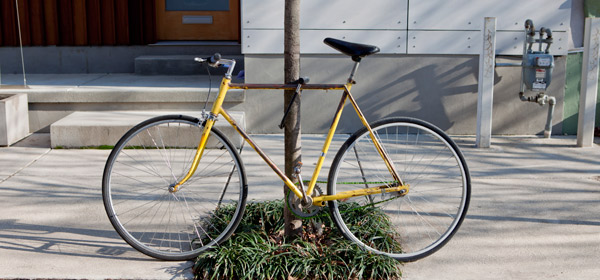 story by David KanthorHave you ever locked your bike to a tree? Did you know that every time you do this, you damage that tree? The tree’s bark serves as a layer of protection, just as your skin protects you. When you scrape off bark with a chain or lock, the tree becomes more susceptible to disease. It can cost as much as $1,000 to replace a single tree.
story by David KanthorHave you ever locked your bike to a tree? Did you know that every time you do this, you damage that tree? The tree’s bark serves as a layer of protection, just as your skin protects you. When you scrape off bark with a chain or lock, the tree becomes more susceptible to disease. It can cost as much as $1,000 to replace a single tree.
More than 800 bikers commute into Center City from the south each day during morning rush hour. Many more come down the Parkway and across the Schuylkill River bridges. The bike lanes have just been repaved along Spruce and Pine Streets. Plans drawn up by the Philadelphia Planning Commission propose more much-needed downtown bike lanes. An integrated new bike network will help Philadelphia become the “greenest city in America.” But we won’t get there if we are simultaneously killing trees.
Many bikes are locked to trees because it seems more convenient than looking for an unoccupied bike rack, post or sign. Augmenting existing bike parking is an important step towards protecting the city’s trees. Currently, parking meters are in the process of being converted to kiosks, causing the loss of prime bike parking spots. Fortunately, the City has responded by converting many of the old meters into “post and ring” bike racks.
New York City enforces a $1,000 fine for locking your bike to a tree. In Philadelphia, the fine is only $25 and the law is not enforced. I’m not suggesting a $1,000 fine—I’m sure Philadelphia’s bike riders, once they understand the impact, will lock their bikes to designated bike racks, poles and signs. Street trees are important. They provide safe and shaded walking environments, improve air quality, increase property values and absorb stormwater runoff. They are as important to a sustainable environment as riding your bike.
The Center City District prides itself on both its collection of almost 750 well-maintained street trees and its status as a longstanding advocate for bicycle infrastructure enhancements. The next time you park your bike, make the truly green decision: Lock your bike to a bike rack, pole or sign, not to a tree.
David Kanthor is an urban planner who works on accessibility and sustainability projects for the Center City District.


